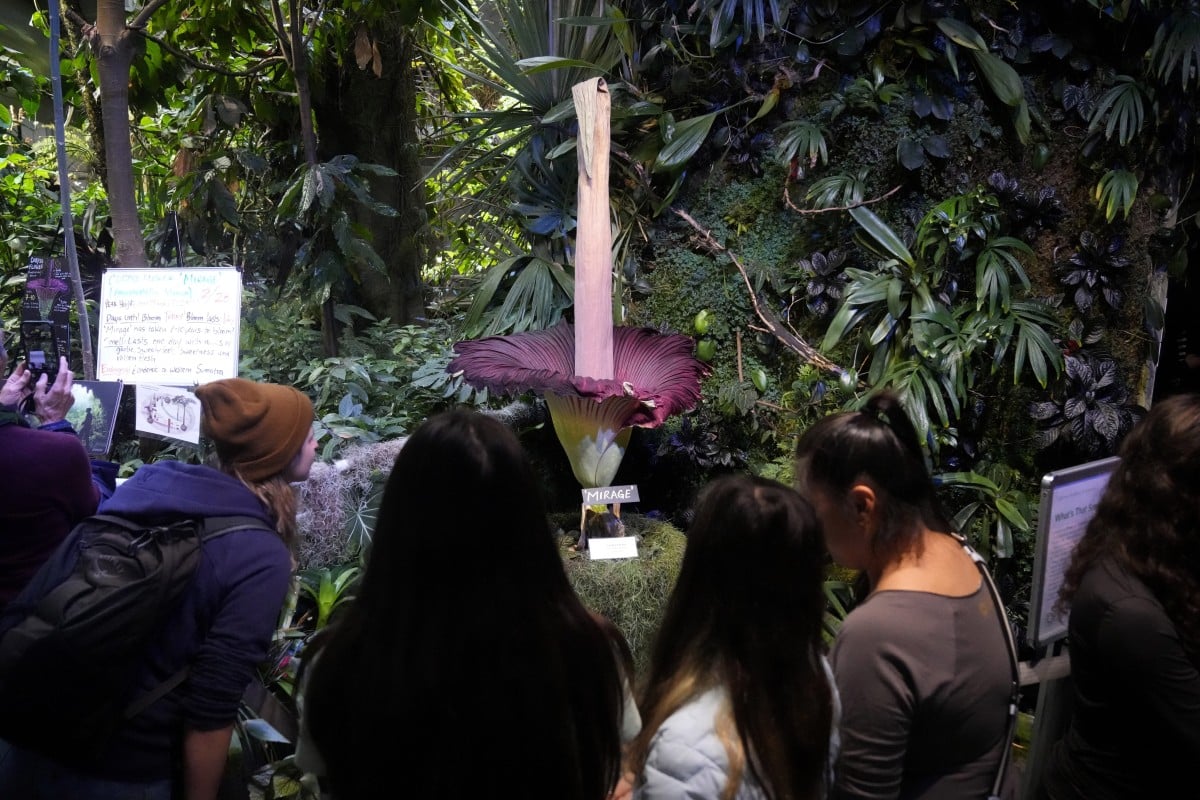
- The ‘Amorphophallus titanium’, an endangered tropical flower, blooms for one to three days once every seven to 10 years
- We did some research to find out how the bad odour is produced
 Visitors look at a corpse flower in bloom at the California Academy of Sciences’ Osher Rainforest in San Francisco. Photo: AP
Visitors look at a corpse flower in bloom at the California Academy of Sciences’ Osher Rainforest in San Francisco. Photo: APCrowds lined up at the California Academy of Sciences, a research institution and museum in San Francisco, last month to see – and smell – the blooming of an endangered tropical flower that releases a pungent odour when it opens once every several years.
An Amorphophallus titanium, also known as a corpse flower, blooms for one to three days once every seven to 10 years. During the bloom, it releases a powerful smell, described by some as rotting food or sweaty socks (see graphic).
“It’s kind of imitating the smell of ... a dead carcass to ... get all the flies to come and interact with it, pick up pollen, and then take that pollen to another flower that it might investigate due to its smell,” said Lauren Greig, a horticulturist at the California Academy of Sciences.
It was the first bloom for the corpse flower named Mirage, which was donated to the California Academy of Sciences in 2017. It’s been housed in the museum’s rainforest exhibit since 2020.
Bri Lister, a data scientist who lives in San Francisco, waited in line for about an hour to catch a whiff of the plant.
Mechanical flowers project gives students a chance to bloom
“In certain directions, I definitely picked up on the sweaty socks, sweaty gym clothes, but probably luckily not full-on rotting meat, but definitely a smellier plant than average,” Lister said.
Monica Becker took her child out of school to see the flower in person after watching it on the academy’s live stream. “When we heard it bloomed, we were like, ‘We got it, we got to go, first thing in the morning when they open.’ So here we are,” Becker said.
The Amorphophallus titanium is native to the Indonesian island of Sumatra.
The International Union for Conservation of Nature lists it as endangered, and less than 1,000 individual plants remain in the wild.
Are there any other flowers that smell bad?
The Amorphophallus titanium is just one of several types of carrion flowers that smell like rotting meat to attract pollinators.
Here are three others.
Another carrion flower is the stinking corpse lily (Rafflesia arnoldii). Similar to the Amorphophallus titanium, the Rafflesia arnoldii is native to Sumatra. It has reddish-brown flower petals with white speckles. The flower can weigh up to 11kg and grow up to one metre in diameter.
Study Buddy (Explorer): Meet Hong Kong’s ‘Flower Granny’ artist
The stinking root parasite (Hydnora africana) grows underground in the deserts of southern Africa. The only part of the plant that is visible above ground is its reddish-pink flower. This flower smells like poop, which attracts beetles. Tiny hairs inside the flower point downwards, trapping the insects inside. They are only released after they have pollinated the plant.
Western skunk cabbage (Lysichiton americanus) can be found in western North America. Just like the Amorphophallus titanium, it has a spadix and spathe. When the flower blooms, the plant releases a rotten odour to attract flies and beetles. The western skunk cabbage’s roots have laxative properties, and bears eat them after they wake up from their hibernation to get their digestion moving.